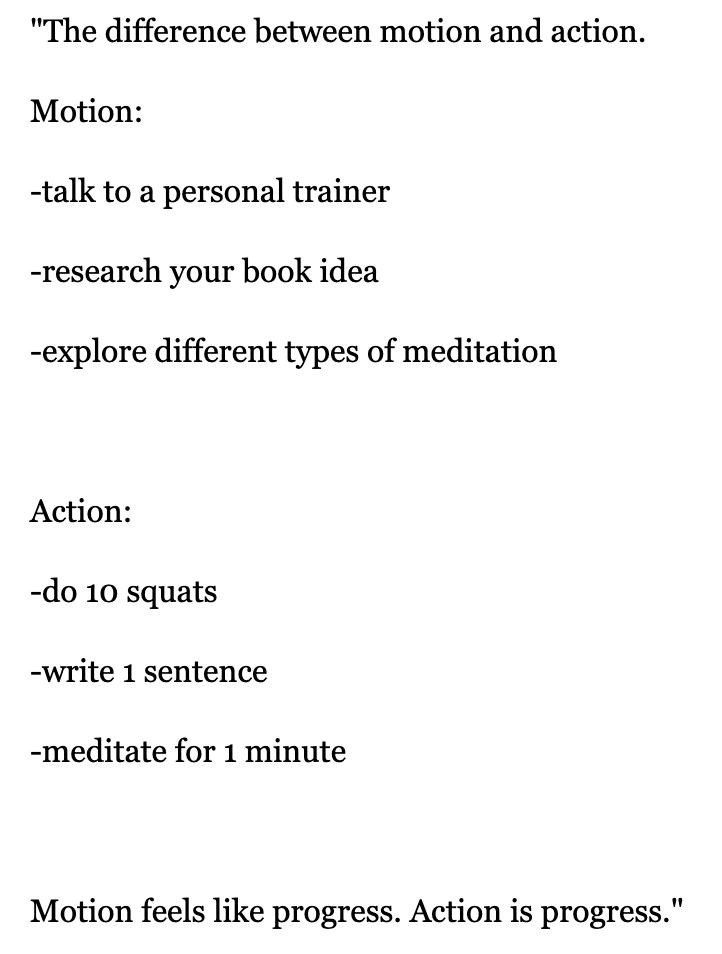Motion and action are mutually reinforcing. And while action may be more visible to others, motion is just as consequential.
In recent weeks, I’ve been thinking about the difference between motion and action from James Clear’s Atomic Habits. It’s a useful distinction and easy to identify in real life once you have the framework.

Motion tends to happen a lot in life — professionally and personally. Motion takes time, energy, and resources. At work, motion happens mostly in the form of meetings: planning for meetings, meetings with no outcomes, and follow-up meetings to discuss open-ended topics from previous meetings. Motion happens individually: reading blogs about how to solve a problem, looking for the best template, labeling and sorting emails in the inbox.
However, motion is not inherently negative. In fact, it’s necessary to a point. Motion creates momentum. Like twirling a lasso, the first few whips around are necessary to put power behind the action. Though if you never throw the lasso, all that momentum goes to waste.
Motion and action are opposite sides of the same coin. They require each other to be whole. Motion, in its best sense, is preparation and makes the resulting action efficacious. These two states go hand-in-hand. They inform each other and have the power to propel you forward.
Some people act too quickly, without adequate preparation or planning. That has not been my experience. I learned in graduate school that motion is my preferred state. It took me two years to finish writing my master’s thesis because I never felt knowledgeable enough to make any claims. One book would lead me to another. Footnotes and reference lists were gold. I could spend weeks on an intellectual tangent before sitting down to write.
It can be difficult to know when to stop motion. One of my colleagues recently shared this in a team Slack channel:
Collin Powell's 40/70 rule:
- When you have about 70% of all the information, you probably ought to decide because you may lose an opportunity.
- Never make a decision with less than 40% of the information you are likely to get, and to gather no more than 70% of the information available
According to Powell, anything less than 40% and you're just guessing. Anything more than 70% and you're stalling over making a decision.
Taking this advice, motion is useful up to the point that it gives us 70% confidence to decide or act. Any motion beyond this is unnecessary effort.
Moving in the Wrong Direction
Not all motion is positive. Sometimes we describe this as spiraling out or going off the deep end. Then, we act poorly because negative motion gains too much momentum. This might look like negative self-talk or thought patterns, a lack of empathy for others, or even an errant search for purpose or belonging.
The frontman for my old college band wrote these lyrics after a summer-long hitchhiking trip from the east to west coast.
Waiting doesn’t necessarily mean staying in the same place. Motion can be retrograde and actions mistakes. — The Busy World
Motion doesn’t always move us forward. Actions aren’t always in our best interest. These two states are mutually reinforcing. Our actions follow the trajectory of our motion. And while action may be more visible to others, motion is just as consequential. Borrowing from data and analytics terminology, the results of an action or decision is a “lagging indicator” of motion. That means careful observation of motion has the potential to be predictive of future action.
Perfect is the Enemy of Good
For as much as I hate gratuitous motion, the right amount incredibly important. It sets the tone and energy behind an inevitable action. The key is knowing when to stop the motion and act. Most people want to make this turn. That’s not the problem. The real obstacle is a lack of confidence.
Whether you choose to use Colin Powell’s 40/70 rule or some other standard or guideline, it’s critical to stay action-oriented. Use motion for momentum, not as a stalling tactic. Voltaire said it best: “Perfect is the enemy of good.”
